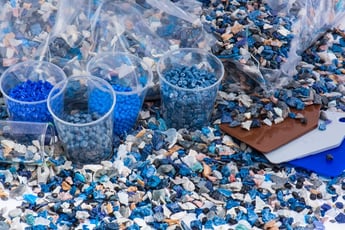
Different plant standards now force us to recover as much material as possible. In some cases companies have the opportunity to recycle plastic using third parties. Others will rely on regrind in-house.
Many of the recycled material will either come from bad parts, leftover pellets, or any other material that doesn't end up in saleable parts. With a push for many states to use repro resin/regrind to improve their environmental impact, there are some serious challenges associated with repro. All of these sources create a mixture of pellet sizes and processing material with wildly different properties. If you are going to be using repro in your parts moving forward, you may need to make some adjustments to your machine in order to avoid contamination issues. Pay attention if you start to notice these issues:
1. Black Specs or Carbon Contamination
Finely ground pellets melt faster because of their size. On the contrary, larger pellets tend to melt slightly slower. You may need to adjust temperatures or else the smaller parts might burn up and cause black specs in your parts. Also, consider the fact that additives can be burned as well. Ironically enough, flame retardants tend to burn readily.
2. Hang-ups and Lumps Clogging Your Machine
When adjusting normal temperatures for a general-size pellet it is possible that larger pellets are coarse and may not be able to melt completely. These can clog the machine in the valve area, nozzle or in the mold. Other times we detect this issue by hearing something drag inside the barrel. Sometimes, these pellets go unnoticed and reach the part. This may look like lumps or become fragile spots in the part.
Additionally, the mixture of small, coarsely ground pellets can cause issues in the feed throat. This is because fines melt quickly, sticking to the wall and trapping larger particles, limiting the flow gradually.
3. Process Variations & Secondary Defects
You are used to processing regular resins. You are comfortable with your process and best practices. But when you start processing repro/regrind, you need to re-adjust often. This is due to the fact that the molten mixture may have a very different MFR, affecting the filling of the mold and causing other visual and mechanical defects.
Even though we can see plastic recycling allows us to reduce costs and promote a cleaner world, we must control these materials by correctly sorting them by polymer type and grain size. Based on this, prepare multiple mixtures and make the appropriate adjustments in the process for each type of formula.
While this is not a post about purging, using a high-quality purging compound like Asaclean is a huge advantage when processing repro or regrind. Regular purging will reduce all of these kinds of degradation.
Ready to reduce your production downtime to protect your profits? Learn more about how purging compounds and process efficiency work in tandem.

Hector Sanchez, the National Sales Manager at Asaclean - Asahi Kasei Plastics North America, leverages his extensive processing expertise to assist extruders and molders in achieving their operational goals. With a focus on reducing scrap and increasing profits, Hector's in-depth knowledge of Asaclean's Purging Compounds has made him a pivotal figure in the industry. Beyond his primary role, Hector is a dynamic speaker, regularly sharing his insights and strategies at webinars and tradeshows nationwide. His innovative approaches and dedication to customer success have established him as a valued leader and mentor in the plastic industry.







Comments